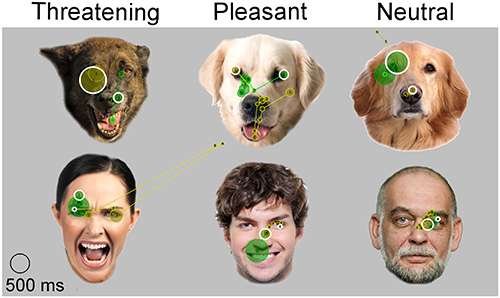Emotions matter—dogs view facial expressions differently

A recent study from the University of Helsinki shows that the social gazing behavior of domestic dogs resembles that of humans: dogs view facial expressions systematically, preferring eyes. In addition, the facial expression alters their viewing behavior, especially in the face of threat. The study was published in the science journal PLOS ONE.
Threatening faces evoke unique responses in dogs
The study utilized eye gaze tracking to demonstrate how dogs view the emotional expressions of dog and human faces. Dogs looked first at the eye region and generally examined eyes longer than nose or mouth areas. Species-specific characteristics of certain expressions attracted their attention, for example the mouths of threatening dogs. However, dogs appeared to base their perception of facial expressions on the whole face.
Threatening faces evoked attentional bias, which may be based on an evolutionary adaptive mechanism: the sensitivity to detect and avoid threats represents a survival advantage. Interestingly, dogs' viewing behavior was dependent on the depicted species: threatening conspecifics' faces evoked longer looking but threatening human faces instead an avoidance response. Threatening signals carrying different biological validity are most likely processed via distinctive neurocognitive pathways.
"The tolerant behavior strategy of dogs toward humans may partially explain the results. Domestication may have equipped dogs with a sensitivity to detect the threat signals of humans and respond them with pronounced appeasement signals", says researcher Sanni Somppi from the University of Helsinki.
Results provide support for Darwin's views of animal emotions
This is the first evidence of emotion-related gaze patterns in non-primates. Already 150 years ago Charles Darwin proposed that the analogies in the form and function of human and non-human animal emotional expressions suggest shared evolutionary roots. Recent findings provide modern scientific support for Darwin's old argument.
Exploring canine mind with dog-friendly methods
A total of 31 dogs of 13 different breeds attended the study. Prior the experiment the dogs were clicker-trained to stay still in front of a monitor without being commanded or restrained. Due to positive training approach, dogs were highly motivated to perform the task.
The study is part of the collaboration project of Faculties of Veterinary Medicine and Behavioural Science, University of Helsinki and Department of Neuroscience and Biomedical Engineering, Aalto University. Previously, the research group of professor Outi Vainio from the University of Helsinki has discovered that socially informative objects in images, as personally familiar faces and social interaction, attract dogs' attention.
The research group of Professor Outi Vainio explores cognition and emotion in dogs in the Faculty of Veterinary Medicine of the University of Helsinki. The study has been supported inter alia by the Academy of Finland and the Emil Aaltonen Foundation.
More information: Sanni Somppi et al. Dogs Evaluate Threatening Facial Expressions by Their Biological Validity – Evidence from Gazing Patterns, PLOS ONE (2016). DOI: 10.1371/journal.pone.0143047
Journal information: PLoS ONE
Provided by University of Helsinki





















